Bugs, Snakes, Spiders and other Critters
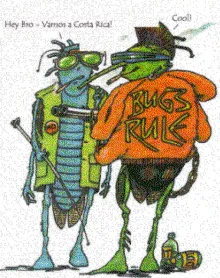
Costa Rica is in the tropics, and although the weather here can be enormously variable, it provides a wonderful environment for those critters with more legs than we.
Whether coming here for a visit or to live, I absolutely guarantee that you will be introduced to a wide variety of creepy crawlies. Whether in Costa Rica or Miami, there are more of them in these tropical or sub-tropical areas and they often grow much larger in these environments.
I live in San José, by far an area with more moderate temperatures than the beaches or rain forests, but we still get a ton of these fellows. In fact, as I write this, there is a spider on the wall over my desk only slightly smaller than a 4X4. I would kill it, but my (Tica) wife would then kill me, so I type a bit, then watch the spider a bit, then type a bit more, etc.
I am not particularly fond of spiders. I know many of them eat bugs and do helpful things around the house, so my discomfort is likely based more on my ignorance. I have no idea if this big boy eying me from next to the picture is looking for a bug breakfast or considering how that Gringo just below him might make for a nice smorgasbord. So we watch each other and neither of us is moving.

As there are about 4,000 varieties of bugs (OK, insects) here, you will be happy to know I am not going to discuss them all. I’ll just cover the ones most people know. For more on the ecology of Costa Rica, click here.
The overwhelming number of insects and spiders are harmless but at times annoying.
But, if you were to take a peek at this monster to the right, thoughtfully submitted by Delores Kinsey, you may doubt my words. However, I am assured by my bug knowledgeable wife that this critter, known as a hercules beetle, is harmless. Funny, but as I recall, my ex-wife also described me that way.
I am NOT a bug expert, so if anyone wants to submit a more authoritative document on this subject, I’ll be happy to add it to this web site. See our submissions page for information on submitting an article for publication.
Oh, and you’ll be happy to know that these babies apparently make fine pets! They may be kept in a glass or plastic aquarium tank. Use native soil (if possible), mulch, and dry leaves to cover the bottom. Give it some bark or cover. Feed it with bananas, peaches, and other soft fruits, and diluted maple syrup. So you moms out there, be open minded when your offspring as if they can keep it!
A general note though. Not everything here is pet quality. Insects and spiders found in the hot tropical areas can be a lot more dangerous than those in the mountainous or valley regions around San José. You are in the tropics, and if you don’t know what something is, best to leave it alone.
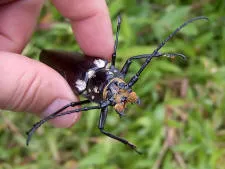
The bug in the photo at left is actually not dangerous at all… though if you woke up and found him on your pillow, the heart attack might be. My sweetie told me that he (she?) is a scarab. I have no idea if this is correct, so all you bug people chill out.
Now, as an UPDATE to this page, I almost DID awaken to find this fellow (or maybe one of his close relatives) on my pillow thanks to my new and bug loving wifey! If you want to read what it is like to have a wife who is “into” bugs, you can read those details here.
Ants in Costa Rica
Probably every person who lives in Costa Rica and who is reading this is already rolling their eyes.
There are ants here, and I mean ants like nobody’s business, and they are everywhere, especially in the house. We have had an ongoing ant war for a bit over three years, and we are not winning. In fact the current Iraq thing could be handled easier. We spray, they die, they breed, they move, we mix stuff up, they die, they breed, they move. I open a kitchen cupboard and there they are. In the rainy season it gets worse. They come in all sizes and they like to share the house. One nice thing is that they do not seem to bite, unlike the nasty little fellows in my back yard (patio) who give a nasty bite that burns and itches.
They are in the coffee maker, the dish washer, the dryer. They love my bathroom and every day there is a little straight line of them busily going somewhere (perhaps the coffee maker). My wife, having lived with ants all her life is a bit more philosophic. She mentions something about protein and drinks her coffee.
In any case, you may win a battle or two, but you are going to lose the war.
The ants you can find in the jungles or rain forests are a different matter. Larger and more aggressive, many can give a nasty bite. There are also a fire ant variety in the Central Valley that can get your attention if you step on their nest without (or maybe with) shoes. I keep a supply in my back yard.
Spiders In Costa Rica
Yeah, the big one IS still there on the wall above my desk.
Unlike ants who generally are an annoyance, there are spiders here who can give a nasty bite. Painful but not fatal. Happily, these are not generally found in the San José area where I live but are more often found in the beach and rain forest areas where the temps are much higher. Saying that, my son’s girlfriend says she found a tarantula in the garage a few weeks ago. It is my understanding that tarantulas can bite, but seldom do so, and only when annoyed or threatened. Spiders are generally shy and unless you are in their environment and getting in their little faces, this is not a big deal. If trekking through a rain forest, listen to the guide as to what protective clothing is advised.
Snakes in Costa Rica
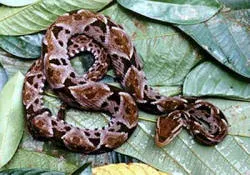
Over 130 different snake species make Costa Rica their home, and this includes some of the world’s most deadly. Bushmasters, coral snakes, and the REALLY dangerous fer-de-lance are famous. The good thing is that these fellows generally live in the jungles hot spots and are generally shy, but there is an exception.
There are also boa constrictors which I am told are not venomous and thus not so dangerous. Still, anything that can squeeze me tighter than my wife is never going to be on my favorite things list.
The fer-de-lance (pictured right) is absolutely deadly, and even if you survive, it inflicts a permanent necrosis to tissue that can be life crippling.
Like most snakes, it prefers to be left alone, but it does sometimes bite humans with little provocation. The fer-de-lance bites several hundred people each year in Costa Rica, mostly those agricultural workers who are in the wrong place at the wrong time. Only about six people in Costa Rica die from the fer de lance.
Because of the ready availability of antivenin produced at the Clodomiro Picado Institute, which makes much of the antivenin used in Central America, deaths from snake bites are low. At the Clodomiro Picado Institute, over 200 snakes, including the fer-de-lance, are “milked” to produce antivenin.
Unless you REALLY know your snakes, leave ALL of them completely alone and walk the other way.
Want to learn more about snakes while you’re here? There are at least two serpentariums here is Costa Rica. The Serpentario de Costa Rica which is still on many web sites and in almost all travel books was closed a few years ago. A brief try to re-open failed, so if you want to see… and maybe handle… snakes, here are two serpentarios.
Serpentario El Mundo de las Serpientes
Located in Grecia, about 45 minutes northwest of San José is the World of Snakes. From their web site, they are an open-air-exhibition with snakes from all over the world. They also say that you can,, if you wish, “…get in close contact with snakes.”. Hmmm! Bring the kids!
Serpentario El Mundo de las Serpientes
| Location: | Grecia, Costa Rica, not far from the metal church (which is another thing you should see!) |
| Hours: | Monday thru Sunday from 8.00 a.m to 4.00 p.m |
| Email: | [email protected] |
| Telephone: | +506-494-3700 |
Serpentario Monteverde Costa Rica
Web Site: Snake Tour
| Location: | Santa Elena, Monteverde, Costa Rica |
| Hours: | There are guided tours all day, from 9:00 a.m. to 06:00 p.m. |
| Email: | none found |
| Telephone: | none found |
Centipedes and Millipedes
These big boys are all over Costa Rica including my house. Last night, my wife came flying out of the bedroom spouting Spanish Ricky Ricardo style. As the “man of the house”, it was my duty to challenge this 6 inch something-pede to a death match. (I did not stop to count the legs, but there were lots). I won, but it took about 31 smacks with my shoe to do it. Many millipedes and I think centipedes DO have a venomous bite as my dog can attest when trying to add a bit of protein to her diet. The swollen face and painful yips are ample proof she found one in the garden (or the bedroom). These fellows may serve some useful purpose, but as I don’t want to step on one in the night, I send them to their maker.
Cockroaches
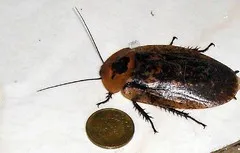
You know the spider on the wall? The big one? He is a baby compared to the cockroaches. While the spider may be a 4X4, the cockroaches may be better described as the Humvees. As everywhere else, they are just gross and CAN be controlled in the house by use of bug killer. Oh… and the cockroaches HERE can fly.
Here is an entry from my blog regarding this matter. Note: In my blog I occasionally use bad words, especially when I am terrified.
Caterpillars
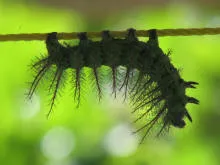
Kids love caterpillars, and often want to touch them. Some varieties are harmless, so can cause itching, and SOME can give a VERY serious injury just by brushing against them.
Unless you know your caterpillars, I would suggest leaving them alone while in Costa Rica and especially if you are near the high temperature – high humidity areas. If in your house, scoop them up with something other than your hands, and move them back outside.
At the right is an especially nasty critter. This photo was taken by Ronna von Knorring, a transplant to Costa Rica from Kansas. She wrote a brief story about her encounter with this bad boy, and you can read it here.
Scorpions
There are a ton of them here and occasionally they visit our house. They come in all sizes. They are definitely more prevalent at the beaches and hotter climates, but can be found anywhere. Most give a nasty and very painful sting, but as far as I know, there are none in Costa Rica capable of killing an adult.
Especially if you are in the warmer areas, make sure one of these lovelies has not decided to spend the night in one of your shoes. If backpacking, shake out your sleeping bag before you climb in. Just a few weeks ago, while scuba diving, a friend received a really painful sting on his leg from a scorpion that felt the wet suit was a fine place to visit. My housekeeper finds about one each month in our house. Be careful.
Email this page to a friend









